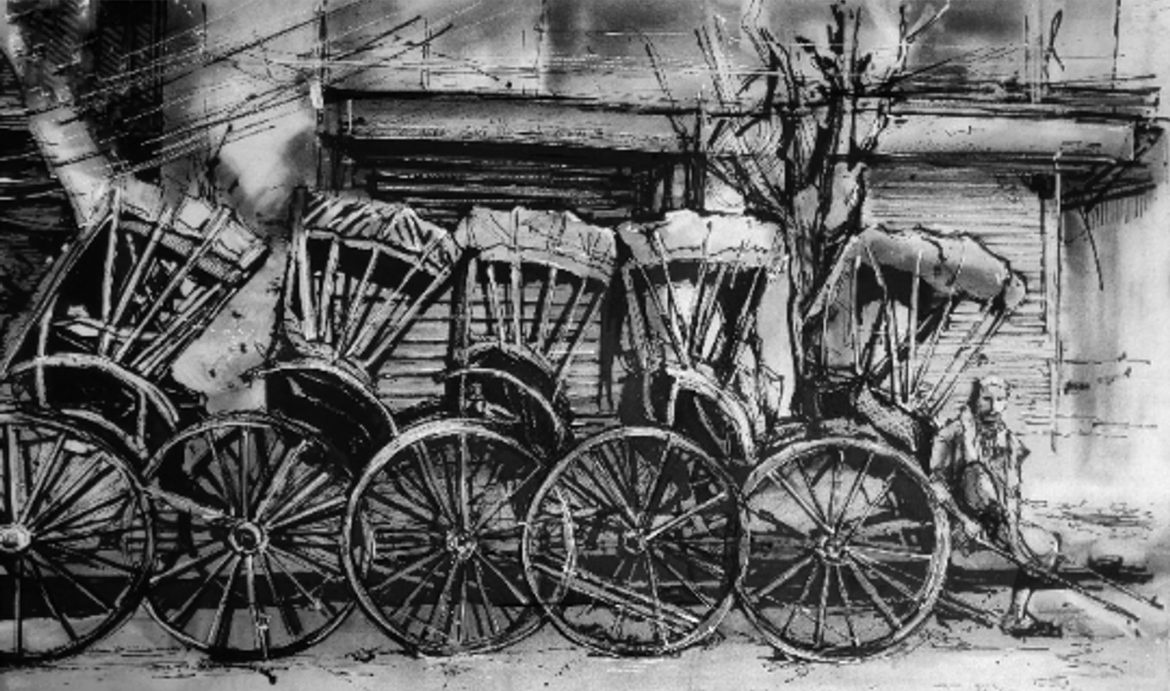The Phantom Rickshaw Puller of Kolkata: A Haunting Tale from the City of Joy
In the labyrinthine lanes of Kolkata, where colonial history and modern chaos intertwine, whispers of The Phantom Rickshaw Puller echo through the monsoon-soaked streets. This spectral figure, a ghostly rickshaw puller from the British Raj, is said to haunt the narrow alleys of North and Central Kolkata, his jingling bells and labored breaths chilling passersby. As one of India’s most enduring urban legends, this tale blends the city’s rickshaw heritage with supernatural intrigue, captivating locals and tourists alike. In this blog, we unravel the eerie story of the Phantom Rickshaw Puller, explore its cultural roots, and reveal why Kolkata remains a hotspot for paranormal enthusiasts.
Kolkata’s Rickshaw Legacy: A Colonial Relic
Kolkata, once the British capital of India, is the last city in the world where hand-pulled rickshaws—known as tanarickshaws—still ply the streets. Introduced in the 19th century by Chinese traders, these human-powered vehicles became a symbol of colonial hierarchy, with barefooted pullers ferrying the elite through waterlogged lanes. Today, around 3,500 rickshaws and 18,000 pullers, mostly migrants from Bihar and Jharkhand, navigate Kolkata’s narrow alleys, a fading icon amid modernization efforts.
The rickshaw’s cultural significance is immortalized in literature and film, from Bimal Roy’s Do Bigha Zamin (1953) to Rudyard Kipling’s The Phantom Rickshaw (1888). While Kipling’s story is set in Shimla, its rickshaw imagery has fueled Kolkata’s ghostly lore, inspiring tales of a spectral puller who never rests.
The Legend of the Phantom Rickshaw Puller
The tale of the Phantom Rickshaw Puller centers on a 19th-century puller named Hari, a Bihari migrant who toiled in Kolkata’s Burrabazar market. According to folklore, Hari was wronged by a wealthy merchant who refused to pay his fare, leading to a violent altercation. Humiliated and destitute, Hari died in a monsoon flood, his rickshaw sinking into the muddy lanes. Before his death, he cursed the city, vowing his spirit would haunt the streets, pulling his rickshaw for eternity.
Locals claim Hari’s ghost appears on rainy nights, his emaciated figure tugging a creaking rickshaw through alleys near Bowbazar, Hatibagan, and Shyambazar. His bells jingle faintly, and his labored breathing echoes, only to vanish when approached. Some say he seeks passengers, offering rides before disappearing, leaving behind a cold chill or muddy footprints.
Paranormal encounters include:
- Ghostly Sightings: Pedestrians report seeing a gaunt man in a lungi pulling a rickshaw, dissolving into mist near old colonial buildings.
- Eerie Sounds: The jingle of rickshaw bells or heavy footsteps in flooded lanes, heard even when no one is visible.
- Unexplained Events: Street vendors near New Market claim goods move inexplicably, attributed to Hari’s restless spirit.
- Haunted Rides: Rare accounts describe passengers boarding a rickshaw, only to find it driverless mid-journey.
The legend thrives in Kolkata’s monsoon season, when flooded streets evoke Hari’s tragic end, amplifying the city’s eerie ambiance.
Myth or Reality? Unraveling the Tale
Skeptics argue the Phantom Rickshaw Puller is a product of Kolkata’s socio-cultural fabric. The rickshaw pullers’ harsh lives—working 12-hour days, earning meager wages, and facing health risks like tuberculosis—fuel narratives of unrested souls. A 2003 study ranked pullers just above ragpickers in income, highlighting their marginalization, which may inspire tales of vengeful spirits.
Rational explanations include:
- Urban Folklore: The story may stem from Kipling’s The Phantom Rickshaw, adapted to Kolkata’s rickshaw culture, blending colonial guilt with local superstition.
- Environmental Factors: Monsoon floods and Kolkata’s dim-lit alleys create optical illusions or acoustic effects, mistaken for ghosts.
- Social Commentary: The legend reflects the exploitation of pullers, symbolizing their “ghostly” existence in society.
Yet, believers, including rickshaw pullers like Mukhtar Ali of the All Bengal Rickshaw Union, insist the spirit is real, tied to the city’s history of injustice. Paranormal investigators report electromagnetic spikes near Burrabazar, though evidence remains anecdotal.
Cultural Impact and Tourism
The Phantom Rickshaw Puller has permeated Kolkata’s identity, featured in Bengali literature and urban myths. Posts on X amplify the tale, with users recounting eerie encounters near Ganesh Talkies. The legend draws ghost hunters to Kolkata’s heritage sites, like the Victoria Memorial and Howrah Bridge, boosting “haunted tourism” alongside the city’s 3,500 rickshaws.
The story also underscores the rickshaw pullers’ plight. Efforts to ban rickshaws, like the 2006 Calcutta Hackney-Carriage Bill, faced resistance from unions, highlighting the need for rehabilitation. The government’s shift to battery-powered rickshaws aims to preserve livelihoods while phasing out this “inhuman” relic.
Why Visit Kolkata’s Haunted Lanes?
Kolkata, the “City of Joy,” offers a blend of history and mystery. Explore North Kolkata’s alleys, visit Burrabazar, or take a rickshaw ride to feel the city’s pulse. Key attractions include:
- Victoria Memorial: A colonial landmark with its own ghost stories.
- Shyambazar: A hub for rickshaw pullers and paranormal tales.
- New Market: A bustling bazaar where Hari’s spirit is said to linger.
Tips for Visitors
- Best Time: Visit during monsoon (June–September) for peak eeriness, or winter for comfort.
- Ghost Hunting: Carry a flashlight and camera; respect local beliefs and avoid flooded lanes at night.
- Safety: Travel in groups, as North Kolkata’s alleys can be disorienting.
- Cultural Respect: Support licensed rickshaw pullers with fair fares, honoring their legacy.
Conclusion: A Ghostly Ride Through Time
The Phantom Rickshaw Puller of Kolkata is more than a ghost story—it’s a haunting reflection of the city’s colonial past and the struggles of its unsung heroes. Whether Hari’s spirit truly roams the rain-soaked lanes or the tale is a cultural echo of injustice, it adds a chilling layer to Kolkata’s charm. Dare to explore the City of Joy’s haunted alleys and listen for the jingle of ghostly bells.
Have you encountered the Phantom Rickshaw Puller or other Kolkata hauntings? Share your tales in the comments, and subscribe for more eerie stories from India’s supernatural heart!
Disclaimer: The Phantom Rickshaw Puller is based on folklore and lacks verified evidence. Approach with curiosity and respect for Kolkata’s heritage.
